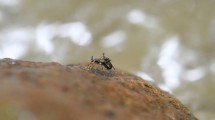Abstract
The mating behavior ofWyeomyia arthrostigma is more complex than that reported forW. smithii. Like some other genera in the tribe Sabethini, flyingW. arthrostigma males approach females perching on vertical sticks. A male aligns himself next to a female by seizing her wing and flipping sideways to land next to her, rather than beneath her. He then performs a series of abdominal bobbing movements, the pair achieves superficial genital coupling while the male's proboscis rotates and snaps down, and the antennae spread farther apart. Finally, the pair shifts to full copulation, and in this phase insemination occurs. In the copulatory position the abdomens of male and female are almost at right angles to each other, made possible by a twisting of the male's terminal segments. The nature of the mating process and its similarity to some elements ofSabethes andTopomyia mating indicate that males may be performing a courtship display.
Similar content being viewed by others
References
Downes, J. A. (1969). The swarming and mating flight of Diptera.Annu. Rev. Entomol. 14: 271–298.
Eberhard, W. G. (1985).Sexual Selection and Animal Genitalia, Harvard University Press, Cambridge, MA.
Frank, J. H., and Curtis, G. A. (1977). On the bionomics of bromeliad-inhabiting mosquitoes. V. A mark-release-recapture technique for estimation of population size ofWyeomyia vanduzeei.Mosq. News 37: 444–452.
Galindo, P. (1958). Bionomics ofSabethes chloropterus Humboldt, a vector of sylvan yellow fever in middle America.Am. J. Trop. Med. Hyg. 7: 429–440.
Gwadz, R. W., Craig, G. B., Jr., and Hickey, W. A. (1971). Female sexual behavior as the mechanism renderingAedes aegypti refractory to insemination.Biol. Bull. 140: 201–214.
Hancock, R. G., Foster, W. A., and Yee, W. L. (1990). Courtship behavior of the mosquitoSabethes cyaneus (Diptera: Culicidae).J. Insect Behav. 3: 401–416.
Okazawa, T., Horio, M., Suzuki, H., and Mogi, M. (1986). Colonization and laboratory bionomics ofTopomyia yanbarensis (Diptera: Culicidae).J. Med. Entomol. 23: 493–501.
Price, R. D. (1958). Notes on the biology and laboratory colonization ofWyeomyia smithii (Coquillett) (Diptera: Culicidae).Can. Entomol. 90: 473–478.
Ryan, M. J. (1994). Mechanisms underlying sexual selection. In Real, L. A. (ed.),Behavioral Mechanisms in Evolutionary Ecology, University of Chicago Press, Chicago, pp. 190–215.
Shannon, R. C. (1931). On the classification of Brazilian Culicidae with special reference to those capable of harboring the yellow fever virus.Proc. Entomol. Soc. Wash. 33: 125–164.
West-Eberhard, M. J. (1984). Sexual selection, competitive communication and species-specific signals in insects. In Lewis, T. (ed.),Insect Communication, Symp. Roy. Entomol. Soc. London, pp. 283-324.
White, T. F. (1978).Larval Diapause in an Ohio Strain of Wyeomyia smithii(Coquillett) with certain comparisons with Aedes triseriatus (Say), M.S. thesis, Ohio State University, Columbus.
Author information
Authors and Affiliations
Rights and permissions
About this article
Cite this article
Philips, T.K., Hancock, R.G. & Foster, W.A. Epigamic display and unique mating position inWyeomyia arthrostigma (Diptera: Culicidae). J Insect Behav 9, 739–753 (1996). https://doi.org/10.1007/BF02213554
Revised:
Issue Date:
DOI: https://doi.org/10.1007/BF02213554




